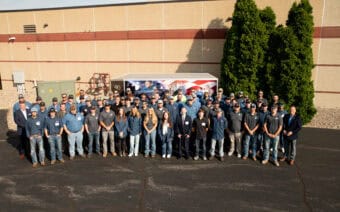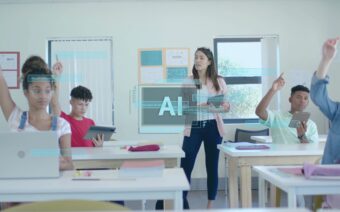
September 9, 2024
As artificial intelligence (AI) technologies continue to advance, they bring transformative potential to the workforce – especially in industries like manufacturing.
However, this transformation also raises important questions about the balance between leveraging automation to enhance productivity and preserving human labor.
Striking this balance is crucial for businesses aiming to harness AI’s benefits without causing undue job displacement.
Current workforce opportunities in the face of pressures
The labor market is undergoing a significant shift, presenting both challenges and strategic opportunities for businesses.
An aging workforce and phased retirements are creating gaps that demand innovative solutions. AI offers a powerful tool for capturing and transferring institutional knowledge, ensuring continuity and supporting less experienced employees stepping into new roles.
By leveraging AI, companies can turn potential knowledge attrition into an opportunity for growth and development.
Simultaneously, the demand for skilled trade labor is increasing, even as the talent pool shrinks due to declining birth rates.
This situation calls for a reimagined approach to workforce planning.
AI can boost the productivity of current employees, enabling them to tackle more complex tasks and mitigate labor shortages.
With up to five generations working together, businesses have a unique chance to foster an inclusive and dynamic work environment.
AI can enhance collaboration across diverse work styles, bridging experience gaps and promoting continuous learning.
By viewing these workforce pressures as opportunities for innovation and growth, companies can create a resilient, adaptable and future-ready workforce that thrives alongside advancing AI technologies.
Lessons from a decade of RPA rollouts
To understand the future impact of AI, it’s useful to reflect on the past decade of Robotic Process Automation (RPA) rollouts.
RPA has demonstrated a spectrum of possibilities, from automating simple, repetitive tasks to more complex cognitive functions.
A critical lesson from these rollouts is that automation does not necessarily lead to job loss – instead, it can redefine job roles and enhance employee performance.
For example, automation can be used to augment human capabilities rather than replace them entirely.
This concept of human-machine collaboration has already led to the creation of new jobs that require different skill sets.
To stay relevant, employees must engage in continuous education and training, adapting to the evolving technological landscape.
Historically, automation has replaced work considered tedious or low-value.
As technology evolves, what is deemed tedious or low-value also changes.
Thus, AI is redefining job roles, not by eliminating positions, but by shifting focus toward higher-value tasks that require human creativity and problem-solving skills.
How AI fills the cognition gap
RPA is evolving beyond simple task automation – it fills the “cognition gap” with AI by performing complex cognitive functions that support human decision-making and problem-solving.
The extent to which AI impacts jobs is significantly influenced by how we interact with AI systems.
Currently, AI interfaces primarily through text, voice and sight – allowing these systems to engage with the real world digitally.
This digital interaction is shaping early AI adoption, particularly in job functions that blend digital tools with real-world applications.
Roles that involve significant digital and real-world interactions are at the forefront of early AI adoption.
Text-based AI interfaces can enhance positions that rely heavily on written communication, like customer service or technical support, by delivering rapid, accurate responses and managing routine inquiries.
Voice interfaces, however, are poised to revolutionize several job functions, especially those that require real-time decision-making and hands-free operation.
In sales operations, voice interfaces and the emergence of outbound AI call bots are making significant inroads.
These AI-driven bots can autonomously conduct initial outreach to potential customers, qualify leads and schedule follow-up appointments, freeing sales representatives from time-consuming tasks.
This enables human sales teams to concentrate on more nuanced aspects of their roles, such as relationship-building and strategic negotiations.
AI call bots can also analyze customer responses in real-time, providing insights that can help tailor subsequent interactions, thereby increasing conversion rates and enhancing overall sales performance.
Voice interfaces also transform roles in environments like manufacturing or logistics, where they can guide employees through complex procedures, offer real-time feedback and reduce cognitive load by simplifying interactions with digital systems.
Meanwhile, sight-based AI interfaces, such as computer vision, are revolutionizing roles requiring real-time visual assessments, including quality control or surveillance.
These interfaces allow AI to “see” and interpret visual data, assisting human workers in making quick and accurate decisions in situations where visual input is critical.
As AI continues to evolve, job functions that align closely with AI’s interaction interfaces – text, voice and sight – will be the first to experience significant transformation.
Additional jobs will be affected as there are advancements in new AI interfaces, as well as new applications for existing interfaces.
The integration of AI into these roles is not about eliminating jobs but about evolving them, allowing workers to focus on strategic, creative and relational aspects – areas where human strengths are unparalleled.
As AI becomes more embedded in business processes, it will continue to foster a more integrated and efficient workflow, supporting a future where technology and human expertise work hand in hand.
What’s hot and what’s not – for early AI adoption
As businesses evaluate how to integrate AI into their operations, it’s crucial to understand which job functions are most conducive to early AI adoption and which are less likely to be impacted in the near term.
AI adoption varies significantly across industries, influenced by the nature of the work and the available AI technologies.
Here’s a look at what’s hot and what’s not for early AI adoption.
Hot: Job functions primed for early AI adoption
- Sales: AI is making significant inroads in sales, particularly through lead generation. AI-driven phone bots can replace entry-level positions by conducting initial outreach, qualifying leads, and scheduling appointments. This allows high-performing, relational sales agents to focus on strategic relationship-building and closing deals. AI enhances their productivity by taking over routine tasks and providing insights that help improve customer interactions and conversion rates.
- Insurance: AI is transforming insurance claims and policy processing, where repetitive tasks dominate. AI systems can automate much of the work traditionally done by clerks and actuaries, such as data entry, risk assessment, and policy management. This automation speeds up processes, reduces errors, and allows human workers to focus on more complex, nuanced decision-making that requires human judgment.
- Office administration: In office settings, AI tools like Microsoft Copilot are revolutionizing data entry and administrative tasks. Integrated AI can streamline workflows, reduce manual input, and improve accuracy. This allows administrative staff to focus on more strategic initiatives, such as improving office efficiency and supporting executive functions.
- Finance and accounting: AI tools, such as TruePrep.ai, are reshaping roles like credit analysts and bookkeeping, accounting, and auditing clerks. These AI solutions automate routine tasks like data entry, reconciliation, and report generation, allowing financial professionals to focus on higher-value activities, such as financial analysis, forecasting, and strategic planning.
- Brand and marketing: AI is rapidly gaining traction in brand and marketing functions, especially in content creation. AI tools can automate the generation of written content, podcasts, videos, and presentations, enabling marketing teams to scale their efforts, personalize content more effectively, and drive better engagement and results. AI allows marketers to focus on strategy, creativity, and relationship-building rather than routine content production.
Not: Job functions less likely to be impacted by early AI adoption
According to the July 2024 Wisconsin Governor’s Task Force on Workforce and Artificial Intelligence, certain job functions are less likely to see immediate impact from AI due to their reliance on human judgment, physical skills or social interaction.
- Transportation: Roles like heavy and tractor-trailer truck drivers are currently less impacted by AI. Though there is an ongoing development in autonomous driving, widespread adoption is still hindered by technological, regulatory and safety challenges. These roles require complex decision-making and situational awareness that AI has yet to fully replicate.
- Medical services: Home health aides and personal aides are less likely to be replaced by AI. These roles rely heavily on human empathy, care and physical presence, attributes that AI cannot replicate. Though AI can assist in administrative tasks or provide decision support, the core of these roles remains firmly human-centered.
- Logistics: Jobs – such as hand laborers, freight, stock, material movers and order fillers – are less likely to see immediate AI adoption. These roles involve physical tasks and dynamic environments that are challenging for AI and robotics to navigate effectively. Human flexibility and problem-solving remain crucial in these functions.
- Hospitality: Positions like fast food and counter workers are currently less impacted by AI. Despite advances in automation technologies, the human element in hospitality – such as customer service, personalization and adaptability – remains valuable and difficult to replace with AI alone.
- Trade skills: Skilled trades, such as electricians, plumbers and construction workers, are not immediately threatened by AI. These jobs require a high degree of manual dexterity, problem-solving and adaptability to varying environments, skills that AI and robotics have yet to master effectively.
The rise of AI automation in the workforce presents a transformative opportunity for businesses to enhance operations and empower employees by augmenting their capabilities, not replacing them.
By leveraging AI technologies – such as text, voice and sight interfaces – companies can address current workforce challenges (like an aging population and a shrinking labor pool) while enhancing productivity in key functions, including sales, insurance, administration, finance and marketing.
As AI continues to integrate into business processes, it offers a pathway to a more resilient and adaptable workforce – one that embraces continuous learning and innovation, ensuring that both technology and people thrive together in the evolving landscape of work.
 Just dropping by: Odyssey Climbing + Fitness in Ashwaubenon
Just dropping by: Odyssey Climbing + Fitness in Ashwaubenon From the ‘burbs of Milwaukee, Chicago to Wisconsin’s Northwoods
From the ‘burbs of Milwaukee, Chicago to Wisconsin’s Northwoods







